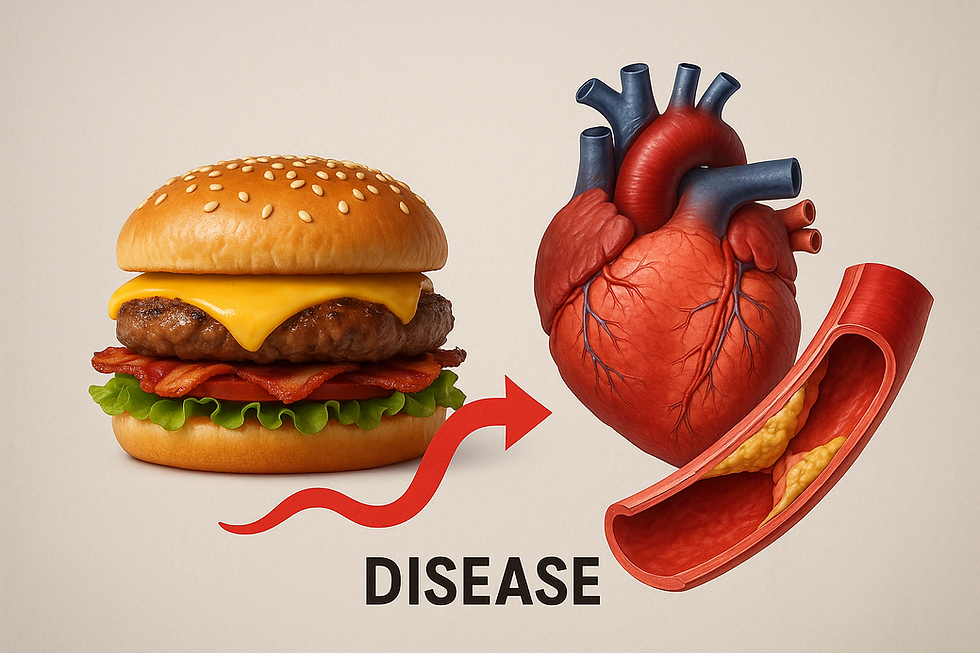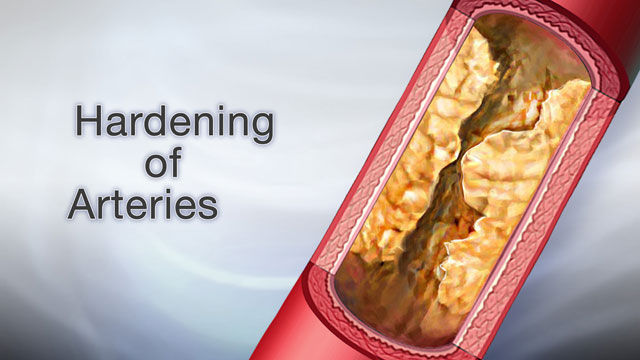Ate To Death
- Ashley Brantley

- Jul 21, 2025
- 8 min read
Updated: Jul 23, 2025
Chronic Disease: Cardiovascular Disease
By: Ashley Brantley of S.M.A.R.T. Vegan, April 08, 2025
Answer this quick survey to help us discover the average health of our followers.
Do you have one or more chronic diseases, such as cardiovascular disease, type 2 diabetes, cancer, obesity, chronic respiratory disease, Alzheimers or dementia?
0%Yes, I have one or more of these conditions.
0%No, I don't have any of these conditions.

What if I told you the food on your plate is quietly deciding your fate? Not just your mood or your waistline, but your future with chronic disease?
Yes, what you eat can cause illness or prevent it. From heart disease and cancer to diabetes and autoimmune conditions, the most common killers in this country often start at the dinner table.
Food isn't just fuel, it’s information. And every bite sends a message to your body: heal me or hurt me.
In a world full of processed convenience and conflicting nutrition advice, it's easy to lose sight of how powerful food really is. This blog is here to reconnect those dots, help reclaim the fact that diet does cause disease, and make more people aware that they're eating themselves to death!
It's Not A Theory. There's A Direct Link Between Food & Chronic Disease
Chronic diseases are conditions that last a year or more, require ongoing medical attention, and limit daily activities. In short, once they're in your life, they stick around much longer than you'd like, mess with your energy and drain your pockets. Roughly 60% of American adults have at least one chronic disease, and 40% have two or more (CDC).
There are several characteristics of chronic conditions worth noting.
First is the slow progression of chronic disease. You don’t catch heart disease overnight.
Next is the long-term damage. Sometimes the consequences of these conditions can be permanent and fatal.
After that comes the need for lifelong management. You’ll be popping pills like an addict for the rest of your life.
Last and most importantly, they’re all lifestyle-driven, and your diet is the greatest factor!
The Big Eight : Eight Categories of Chronic Disease
There are 8 conditions that are known as chronic diseases. They are listed below.
Chronic Condition | Brief Description |
|---|---|
Cardiovascular Disease | Cardiovascular disease refers to a group of heart and blood vessel disorders that include, coronary artery disease, heart attacks, stroke, high blood pressure, heart failure and arrhythmias. It occurs when the blood vessels or heart becomes damaged or blocked, which can restrict blood flow. The main causes of CVD are often linked to unhealthy lifestyle choices, particularly poor diet, lack of exercise, smoking and excessive alcohol sonsumtion. Diets high in saturated fats, trans fats, sodium and sugar contribute to the buildup of plaque in the arteries. |
Type 2 Diabetes | Type 2 diabetes is a chronic condition where the body either becomes resistant to insulin or doesn’t produce enough. This leads to high blood sugar levels, which, if left uncontrolled, can cause damage to organs and blood vessels. It’s primarily linked to poor diet, especially diets high in sugary foods, processed carbs, and fatty foods. |
Cancer | Cancer refers to a group of diseases where abnormal cells grow uncontrollably. There are over 100 types of cancer, but many, including colorectal, breast, prostate, and stomach cancers, have been linked to diet and lifestyle choices. |
Chronic Respiratory Disease | Chronic respiratory diseases (CRDs) are a group of diseases that affect the lungs and breathing. The most common ones are Chronic Obstructive Pulmonary Disease (COPD), asthma, and chronic bronchitis. These conditions can cause shortness of breath, wheezing, and chronic coughing, often leading to long-term disability. |
Obesity | Obesity is a condition where a person has an excessive amount of body fat. It’s commonly measured by BMI (Body Mass Index), but the critical factor is the fat distribution and its effect on overall health. Obesity is strongly associated with a higher risk of developing other chronic diseases, including heart disease, diabetes, and certain cancers. |
Chronic Kidney Disease | Chronic kidney disease is the gradual loss of kidney function, often due to high blood pressure or diabetes. If left untreated, it can lead to kidney failure. |
Alzheimer's & Dementia | Alzheimer’s is a neurodegenerative disease that causes progressive memory loss and cognitive decline. It’s often linked to aging, but early onset is becoming a concern. |
Autoimmune Disease | Autoimmune diseases occur when the body's immune system mistakenly attacks its own healthy cells and tissues. This happens because the immune system cannot distinguish between harmful invaders (like viruses or bacteria) and the body’s normal cells. There are over 80 types of autoimmune diseases, affecting various parts of the body, including the joints, skin, nerves, and internal organs. Some of the most common autoimmune conditions include rheumatoid arthritis, lupus, multiple sclerosis (MS), Hashimoto’s thyroiditis, and type 1 diabetes. |
Hypertension (High Blood Pressure) | Hypertension is a chronic condition where the blood pressure in the arteries is consistently too high. This increases the risk of heart disease, kidney disease, and stroke. It’s often called the silent killer because it shows no symptoms. |
Did You Peep The Connections

Every single one of these conditions can either be managed or reversed through modifying our lifestyle and diet. Peep the connections between these diseases and diet.
Cardiovascular Disease is often a result of an unhealthy diet.
Type 2 Diabetes is often the result of an unhealthy diet.
Numerous types of Cancer are associated with an unhealthy diet.
Diet has been identified as both a cause and a management factor for Chronic Respiratory Disease.
Obesity results from an unhealthy diet.
Chronic Kidney Disease frequently results from high blood pressure or diabetes, both of which are conditions linked to an unhealthy diet.
Alzheimer's and Dementia have been associated with an unhealthy diet and are sometimes referred to as Type 3 Diabetes.
Many Autoimmune Diseases can be controlled through diet.
High Blood Pressure can also result from an unhealthy diet.
It's no mystery that food is the main factor in America's health crisis. To understand how food correlates to disease, we're going to explore the connection between food and disease - one disease at a time.
Spoiler alert: those cells are not fans of deep-fried everything!
Exploring Disease On A Cellular Level
Cardiovascular Disease

Cardiovascular disease is all about your arteries, the heart and it's ability to pump blood throughout your body. Our heart has two chamber within it. We call them the left and right ventricles. These ventricles are placed at the bottom of the heart and helps pump blood out to the body.
The right ventricle pumps oxygen-poor blood to the lungs so that the blood can be oxygenated.
The left vetricle pumps oxygen-rich blood to the entire body through the aorta.
The aorta is like the mother of all the arteries. It shoots out the left ventricle and then branches off into smaller arteries to deliver the oxygen-rich blood to the rest of the body. It's these very arteries that your poor diet is destroying. Let's explore how.
Anatomy of An Artery
Your arteries consist of three layers, with the innermost layer, the endothelium, acting like a Teflon coating for your blood vessels.


This protective layer is made up of flat and thin endothelial cells composed with collagen and other proteins that helps this layer;
Ensure smooth blood flow
Prevent adhesion.
This layer also releases nitric oxide, a tiny gas molecule that dialates and relaxes blood vessels by reducing inflammation and keeping blood flowing smoothly. Unfortunately, this critical layer is super fragile and thin, thus highly susceptible to damage caused by conditions resulting from our lifestyle and dietary choices. Such as;
High LDL ("bad") cholesterol
High blood sugar (from sugary foods)
High blood pressure
Toxins from smoking or processed foods
Chronic inflammation
You may be wondering, "How does something as simple as high blood pressure damage the protective layer of our arteries?" The answer is simple.
High Blood Pressure & Cardiovascular Disease
A poor diet, high in sodium, sugar, saturated/trans fats, and low in potassium raises blood pressure by increasing blood volume, stiffening arteries, damaging the endothelium, and disrupting hormonal and nervous system regulation.
Imagine a stream of water blasting through a hose at 5x the normal pressure. That's what high blood pressure does to your arteries with every single heart beat. That strong flow stretches the vessel walls to the point that it creates tiny tears in the endothelium.

Those tears in the endothelium makes this layer less smooth and kicks the arteries into repair mode, causing the endothelial cells to start producing ROS (reactive oxygen species), in which is supposed to help kill pathogens, breakdown damaged cells and help signal other cells to come clean up the mess, to help patch up the tears... but there's a problem. The tears in the endothelium also makes it easy for other damage causing elements like LDL ( low-density lipoprotein) to slip into those tears and become stored underneath the endothelium, as if the artery was storing drugs within it's walls. This storage of LDL underneath the endothelium not only causes the artery to become more narrow and easier to clog, but it also sparks a whole other chemical reaction with ROS present that only makes matters worst.
When the trapped LDL encounters the reactive oxygen species, it becomes oxidized. Meaning it reacts to oxygen in a bad way. Oxidized LDL is toxic and triggers another immune response from your body that only worsens the situation.
The oxidized LDL releases inflammatory chemicals such as cytokines and chemokines within the artery. The release of these chemicals act as a signal for nearby circulating monocytes to go to the scene and squeeze through the vessel wall.
Once there, the monocytes transform into macrophages (big cells that eat other cells). These macrophages act like the arteries clean up crew and vacuum up all the oxidized LDL. This sounds great, but there's another problem, these macrophages don't know how to stop. They keep eating and eating and eating until they're bloated with oxidized LDL. Once bloated, these macrophages morph into foam cells that sit there and accumalate. Causing the formation of "fatty streaks", which are the first signs of atherosclerosis within the artery.

Eventually, this toxic congestion develops into plaque, composed of:
Fat
Cholesterol
Calcium
Dead cells
Cellular debris
Think of it as a scab inside your artery. The artery hardens, and the body attempts to protect and reinforce the area, but instead of healing, this results in calcification.
Calcium deposits in the plaque cause the once-flexible artery wall to harden and stiffen. This condition is known as “hardening of the arteries.”
Stiff arteries can’t expand properly when blood flows through them, leading to:

Increased blood pressure
Reduced oxygen delivery to your heart and brain
A higher likelihood of plaque breaking off, causing a heart attack or stroke
The alarming part is that hardened plaque can rupture, exposing its toxic core to the bloodstream. The body treats it as a significant wound, forming a blood clot.
If that clot obstructs an artery to your heart: heart attack. If it blocks one to your brain: stroke.

In Summary
The foods you eat causes the internal conditions that damages and harden your arteries, leading to heart disease and fatal clotting or ruptures. This doesn’t happen overnight but over years of neglecting your health.
So now that you understand how food can damage arteries and cause cardiovascular disease, let's explore which specific foods and diets cause cardiovascular disease.
Saturated & Trans Fats = Artery Blockers
Foods high in saturated fats (like red meat, butter, cheese) and trans fats (found in fried and processed foods) elevate LDL cholesterol, the “bad” type. This cholesterol accumulates as plaque in your arteries, narrowing them and increasing the risk of heart attacks and strokes.
Excess Sugar = Inflammation & Damage
Excessive sugar intake (such as from sodas, desserts, refined carbs) spikes blood sugar and insulin. Over time, this harms blood vessels, leading to chronic inflammation, insulin resistance, and diabetes, all of which elevate heart disease risk.
High Sodium = High Blood Pressure
Excessive salt (common in packaged and fast foods) causes water retention, raising blood pressure. Hypertension acts like a battering ram on your arteries, wearing them down and increasing the risk of heart failure, stroke, and aneurysms.
Processed Foods = Poor Nutrient Profile
Highly processed foods are typically low in fiber, vitamins, and minerals but high in harmful fats, sugar, and sodium. This combination contributes to obesity, metabolic syndrome, and inflammation, all key drivers of heart disease.
Low Fiber = Higher Risk
Fiber from fruits, veggies, legumes, and whole grains helps eliminate cholesterol and supports healthy blood sugar levels. A lack of fiber allows cholesterol and blood sugar to rise unchecked.
Final Thoughts
There's power in our choices. What we decide to eat has the power to either fight or fuel chronic disease. Meat, fried and processed foods, excess sugar, high sodium and low fiber diets are amongst the causes of cardiovascular disease and so much more. Ditch or moderate the consumption of theses foods to take control of your health!






Comments